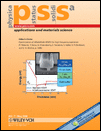Crack free monolithic nitride vertical-cavity surface-emitting laser structures and pillar microcavities
Abstract
We report on the successful fabrication and optical investigation of monolithicly grown GaN based vertical-cavity surface-emitting laser structures featuring quality factors of 250. Short-period AlN/InGaN superlattices are used for the low-index layers of the distributed Bragg reflectors. Pillar microcavities are realized by focused-ion-beam etching. Micro-photoluminescence measurements reveal the longitudinal and transversal mode spectra of the cavities in good agreement with theoretical calculations based on a vectorial transfer matrix method. (© 2006 WILEY-VCH Verlag GmbH & Co. KGaA, Weinheim)




